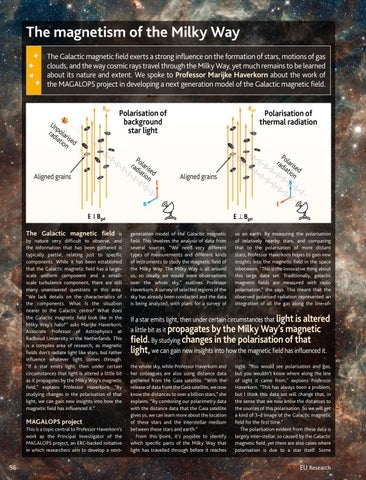The magnetism of the Milky Way The Galactic magnetic field exerts a strong influence on the formation of stars, motions of gas clouds, and the way cosmic rays travel through the Milky Way, yet much remains to be learned about its nature and extent. We spoke to Professor Marijke Haverkorn about the work of the MAGALOPS project in developing a next generation model of the Galactic magnetic field.
The Galactic magnetic field
is by nature very difficult to observe, and the information that has been gathered is typically partial, relating just to specific components. While it has been established that the Galactic magnetic field has a largescale uniform component and a smallscale turbulence component, there are still many unanswered questions in this area. “We lack details on the characteristics of the components. What is the situation nearer to the Galactic centre? What does the Galactic magnetic field look like in the Milky Way’s halo?” asks Marijke Haverkorn, Associate Professor of Astrophysics at Radboud University in the Netherlands. This is a complex area of research, as magnetic fields don’t radiate light like stars, but rather influence whatever light comes through. “If a star emits light, then under certain circumstances that light is altered a little bit as it propagates by the Milky Way’s magnetic field,” explains Professor Haverkorn. “By studying changes in the polarisation of that light, we can gain new insights into how the magnetic field has influenced it.”
MAGALOPS project This is a topic central to Professor Haverkorn’s work as the Principal Investigator of the MAGALOPS project, an ERC-backed initiative in which researchers aim to develop a next-
56
generation model of the Galactic magnetic field. This involves the analysis of data from several sources. “We need very different types of measurements and different kinds of instruments to study the magnetic field of the Milky Way. The Milky Way is all around us, so ideally we would want observations over the whole sky,” outlines Professor Haverkorn. A survey of selected regions of the sky has already been conducted and the data is being analyzed, with plans for a survey of
us on earth. By measuring the polarisation of relatively nearby stars, and comparing that to the polarisation of more distant stars, Professor Haverkorn hopes to gain new insights into the magnetic field in the space inbetween. “This is the innovative thing about this large data set. Traditionally, galactic magnetic fields are measured with radio polarisation,” she says. This meant that the observed polarised radiation represented an integration of all the gas along the line-of-
If a star emits light, then under certain circumstances that light is altered a little bit as it propagates by the Milky Way’s magnetic field. By studying changes in the polarisation of that light, we can gain new insights into how the magnetic field has influenced it. the whole sky, while Professor Haverkorn and her colleagues are also using distance data gathered from the Gaia satellite. “With the release of data from the Gaia satellite, we now know the distances to over a billion stars,” she explains. “By combining our polarimetry data with the distance data that the Gaia satellite gives us, we can learn more about the location of these stars and the interstellar medium between these stars and earth.” From this point, it’s possible to identify which specific parts of the Milky Way that light has travelled through before it reaches
sight. “You would see polarisation and gas, but you wouldn’t know where along the line of sight it came from,” explains Professor Haverkorn. “This has always been a problem, but I think this data set will change that, in the sense that we now know the distances to the sources of this polarisation. So we will get a kind of 3-d image of the Galactic magnetic field for the first time.” The polarisation evident from these data is largely inter-stellar, so caused by the Galactic magnetic field, yet there are also cases where polarisation is due to a star itself. Some
EU Research
